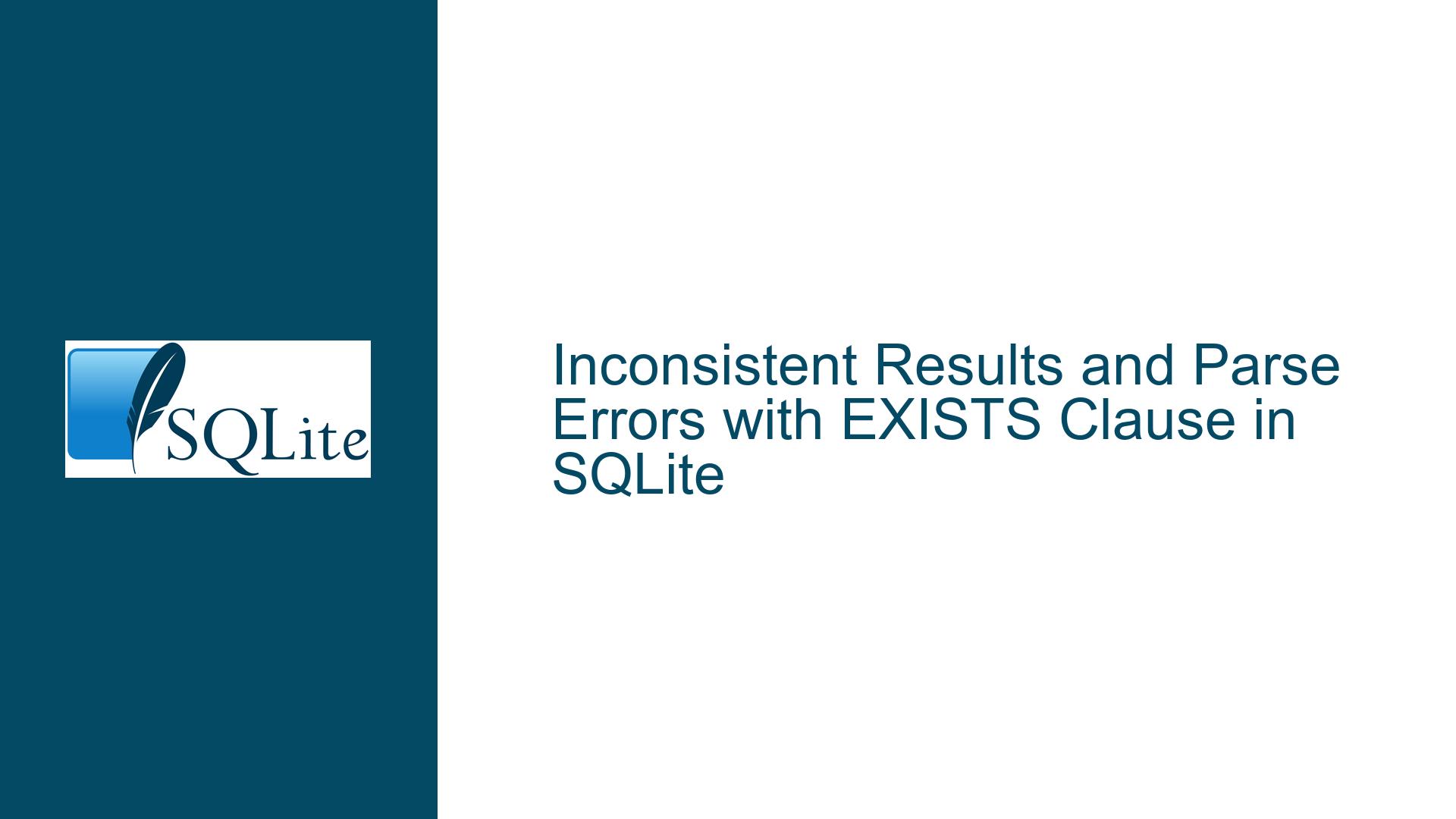Inconsistent Results and Parse Errors with EXISTS Clause in SQLite
Issue Overview: Inconsistent Behavior with EXISTS Clause and Aggregate Functions
The core issue revolves around the inconsistent behavior of SQLite when executing queries involving the EXISTS clause and aggregate functions, specifically the count() function. The problem manifests in two primary ways:
Inconsistent Results: A query that uses the
EXISTSclause with aWHERE falsecondition returns a result, while the same query with aWHERE not truecondition triggers a parse error. This inconsistency is unexpected becausefalseandnot trueare logically equivalent in SQLite.Parse Errors with Aggregate Functions: The parse error occurs when the
count()function is used in aHAVINGclause, where the argument tocount()is a column from an outer query. This is technically an error because aggregate functions likecount()are designed to operate on rows within the same query scope, not across nested queries. However, the error is only triggered under certain conditions, leading to confusion.
The inconsistency arises because SQLite’s query optimizer sometimes skips certain validation steps when it encounters conditions like WHERE false. This optimization can lead to the query executing without raising an error, even though the query contains a misuse of aggregate functions. When the condition is changed to WHERE not true, the optimizer does not skip the validation, and the error is correctly identified.
Possible Causes: Misuse of Aggregate Functions and Query Optimization
The root cause of the issue lies in the misuse of aggregate functions and the way SQLite’s query optimizer handles certain conditions. Let’s break down the key factors contributing to this problem:
Misuse of Aggregate Functions: The
count()function is being used in aHAVINGclause with an argument (ref_0.c0) that references a column from the outer query. This is invalid because aggregate functions likecount()are designed to operate on rows within the same query scope. When used incorrectly, SQLite should raise a parse error. However, due to the way the query is structured, this error is not always detected.Query Optimization and Short-Circuiting: SQLite’s query optimizer employs various techniques to improve performance, including short-circuiting evaluation of conditions. When a condition like
WHERE falseis encountered, the optimizer may skip certain validation steps because the condition guarantees that no rows will be returned. This can lead to the query executing without raising an error, even if it contains invalid SQL constructs. However, when the condition is changed toWHERE not true, the optimizer may not apply the same short-circuiting logic, causing the error to be detected.Logical Equivalence of Conditions: While
falseandnot trueare logically equivalent in SQLite, the way they are processed by the query optimizer can differ. This difference in processing can lead to inconsistent behavior, as seen in the test cases. The optimizer’s handling of these conditions is not always predictable, especially when dealing with nested queries and aggregate functions.Scope of Aggregate Functions: Aggregate functions like
count()are designed to operate on rows within the same query scope. When used in a nested query, the function should only reference columns from the inner query. Referencing columns from an outer query is invalid and should result in a parse error. However, due to the optimizer’s behavior, this error is not always detected.
Troubleshooting Steps, Solutions & Fixes: Resolving Inconsistent Results and Parse Errors
To address the inconsistent results and parse errors, it is essential to understand the correct usage of aggregate functions and the behavior of SQLite’s query optimizer. Below are detailed steps to troubleshoot and resolve the issue:
Correct Usage of Aggregate Functions: Ensure that aggregate functions like
count()are used correctly within the appropriate query scope. When using aggregate functions in aHAVINGclause, the function should only reference columns from the same query. If you need to reference columns from an outer query, consider restructuring the query to avoid misuse of aggregate functions.For example, instead of:
SELECT * FROM t1 AS ref_0 WHERE NOT EXISTS ( SELECT * FROM ( SELECT ref_1.c0 AS c0 FROM t0 AS ref_1 GROUP BY ref_1.c0 HAVING (count(ref_0.c0)) = 1 ) AS subq_0 WHERE false );You could rewrite the query to avoid referencing the outer query column in the
HAVINGclause:SELECT * FROM t1 AS ref_0 WHERE NOT EXISTS ( SELECT * FROM t0 AS ref_1 WHERE ref_1.c0 = ref_0.c0 GROUP BY ref_1.c0 HAVING count(*) = 1 );Avoid Short-Circuiting Conditions: Be cautious when using conditions like
WHERE falseorWHERE not truein queries involving aggregate functions. These conditions can lead to inconsistent behavior due to the optimizer’s short-circuiting logic. Instead, ensure that the query is structured correctly to avoid relying on such conditions.Validate Query Logic: Before executing a query, validate the logic to ensure that aggregate functions are used correctly and that there are no references to outer query columns within the
HAVINGclause. This can help prevent parse errors and ensure consistent results.Test with Different Conditions: If you encounter inconsistent results, test the query with different conditions to identify any patterns in the behavior. For example, try replacing
WHERE falsewith other conditions to see if the error persists. This can help you understand how the optimizer is handling the query and identify any potential issues.Use Explicit Joins: In some cases, using explicit joins instead of nested queries can help avoid issues with aggregate functions and scope. Explicit joins make it clearer which columns belong to which tables, reducing the risk of referencing outer query columns incorrectly.
For example:
SELECT * FROM t1 LEFT JOIN t0 ON t1.c0 = t0.c0 GROUP BY t1.c0 HAVING count(t0.c0) = 1;Check SQLite Documentation: Refer to the SQLite documentation for detailed information on the correct usage of aggregate functions and the behavior of the query optimizer. The documentation provides valuable insights into how SQLite processes queries and can help you avoid common pitfalls.
Update SQLite Version: Ensure that you are using the latest version of SQLite, as newer versions may include bug fixes and improvements related to query optimization and error handling. Updating to the latest version can help resolve any inconsistencies or errors you may be experiencing.
Consult the SQLite Community: If you are unable to resolve the issue, consider consulting the SQLite community or forums for additional insights. Other users may have encountered similar issues and can provide valuable advice or solutions.
By following these troubleshooting steps and solutions, you can resolve the inconsistent results and parse errors caused by the misuse of aggregate functions and the behavior of SQLite’s query optimizer. Ensuring the correct usage of SQL constructs and understanding the optimizer’s behavior are key to achieving consistent and accurate query results.






